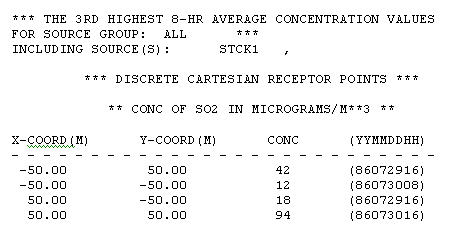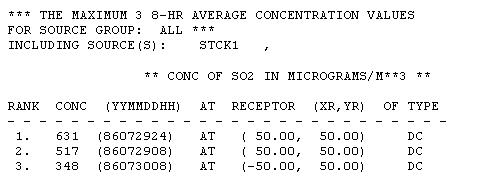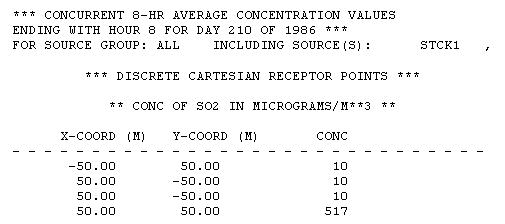 |
| Volume 8 - Issue 12 |
Monthly Newsletter
- December 2007 |
|
|
|
News & Events
|
Season's Greetings from Lakes Environmental!
|
 |
Lakes Environmental sends you our best wishes for a wonderful Holiday Season and a successful 2008.
Our offices will be closed for the holiday season on:
• Monday, December 24th, 2007
• Tuesday, December 25th, 2007
• Wednesday, December 26th, 2007
• Monday, December 31th, 2007
• Tuesday, January 1th, 2008
|
We wish to thank all our subscribers for taking the time
to read our newsletter. We value your feedback and suggestions and look forward to hearing from you in
the new year. |
Thank You to Tech Support Survey Participants & Congratulations to the Contest Winner
|
|
The Technical Support team at Lakes Environmental would like to thank all of our in-maintenance
customers who took the time to fill out the Tech Support Survey. We appreciate all of the feedback,
and look forward to making our support services the best they can be.
The winner of the Apple® iPod® Nano is Mr. Rod Skeen from the Confederated Tribes of the Umatilla
Indian Reservation from the Department of Science and Engineering. Congratulations Rod!
|
Lakes Environmental Trains PDVSA Personnel in Venezuela
|
|
PDVSA chose Lakes Environmental to conduct a 2-day
AERMOD training course in Venezuela on November 29th and
30th, 2007. PDVSA is the largest oil and gas company
in Venezuela. Thanks to the course
participants and organizers from PDVSA.
|
Upcoming Courses
|
AERMOD Course in Toronto Rapidly Filling Up
Our 2-day AERMOD air dispersion modeling course in Toronto on January 24th and 25th, 2008 is
rapidly filling up. Register now to attend! To meet the demand, we are also looking at additional
Toronto dates in the spring and fall of 2008. If you would like to be included on a waiting list
for the spring and fall dates, please contact us at training@weblakes.com.
|
Space Available in AERMOD & CALPUFF Courses in Beijing, China
Lakes Environmental, in conjunction with SinoCAN Intellitech
Ltd, still has space available in two air dispersion modeling
courses in China. Dr. Jesse Thé will train
participants in the AERMOD and CALPUFF models from January
14-18, 2008 in Beijing. The course will be taught in English;
a translator will be
available, and the course materials will be in Chinese.
To sign up for the course, please contact Mrs. Gao
Shuang at (+8610) 6238-5223 or
g-shuang@263.net.
|
 |
Distributor News
|
Sinocan Intellitech Ltd. - Beijing, China
|
Air Pollution Dispersion Models Booming in China
After SinoCAN Intellitech Ltd. signed an agreement with Lakes Environmental for the distribution rights for China in August 2007, Lakes Environmental’s products have burst onto China’s environmental consulting industry. SinoCAN has set up OpenSunday for training and OPEN T&T (Tue. & Thur.), where participants can experience AERMOD and CALPUFF air modeling, based on Lakes Environmental’s popular software packages. By the end of November, SinoCAN successfully completed and delivered its first Lakes Environmental software sale to an end user in China. Additionally, SinoCAN will host AERMOD and CALPUFF air dispersion modeling workshops in China, taught by Dr. Jesse Thé from January 14-18, 2008 in Beijing.
With technical support from Lakes Environmental, SinoCAN has completed the Chinese version of AERMOD
View™, and will produce a Chinese version of CALPUFF View™ by the first quarter of 2008. SinoCAN has
also completed the translation of the US EPA’s AERMOD User’s Guide, and EarthTech. Inc’s CALPUFF User’s
Guide into Chinese. This provides a much needed technical reference for the Chinese air modeling
industry. All of these efforts will definitely boost China’s efforts in pollution reduction.
|
| BACK |
 |
Upcoming Courses
|
We’ve set a number of training dates for 2008, with additional courses to be
announced soon! Be sure to register in advance; spots are limited.
|
AERMOD Courses
|
| Jan. 14-15, 2008 |
Beijing, China |
Outline/Registration
coming soon |
| Jan. 24-25, 2008 |
Toronto, ON, Canada |
|
|
| Feb. 04-05, 2008 |
Houston, TX, USA |
|
|
| Mar. 03-04, 2008 |
Los Angeles, CA, USA |
|
|
| Mar. 10-11, 2008 |
Săo Paulo, SP, Brazil |
Outline/Registration
coming soon |
| Apr. 28-29, 2008 |
Chicago, IL, USA |
|
|
| May. 12-13, 2008 |
San Francisco, CA, USA |
|
|
| Jun. 2-3, 2008 |
Denver, CO, USA |
|
|
|
CALPUFF Courses
|
| Jan. 16-18,
2008 |
Beijing, China |
Outline/Registration
coming soon
|
| Mar. 12-14, 2008 |
São Paulo, SP,
Brazil |
Outline/Registration
coming soon
|
| May. 14-16, 2008 |
San Francisco, CA, USA
|
|
|
|
For more information on the above courses, such as registration
information, location, and course outlines, please visit our
web site: https://www.weblakes.com/courses.html.
|
| BACK |
 |
Monthly Modeling Tip
|
AERMOD Output Types
|
Part 1: Tabular Outputs
This modeling tip will be the first in a series that explains the different types of outputs available
from the US EPA AERMOD model. In this tip, we will consider the tabular outputs that can be created in the main output file.
There are 3 different tabular outputs that can be created:
• highest values tables (RECTABLE)
• maximum values tables (MAXTABLE)
• daily values tables (DAYTABLE)
Example Project
In order to illustrate the different outputs, we will consider a simple example project. There
are 4 receptors in the project and we are measuring the 8-hour average over 2 days (6 values at
each receptor).
The calculated concentrations (in µg/m3) are as follows:
Day |
Hour |
R1 |
R2 |
R3 |
R4 |
Day 1 |
1-8 |
10 |
10 |
10 |
517 |
| 9-16 |
42 |
13 |
18 |
62 |
| 17-24 |
9 |
9 |
9 |
631 |
Day 2 |
1-8 |
348 |
12 |
12 |
47 |
| 9-16 |
67 |
36 |
34 |
94 |
| 17-24 |
14 |
11 |
320 |
44 |
Highest Values Table - RECTABLE
The highest values tables give a summary of the high values by receptor. We can use the highest
value tables to report the 1st highest value at each receptor, the 10th highest value at each
receptor, or any value in between. The syntax to create a highest values table is as follows:
OU RECTABLE Aveper 1ST 2ND...
Where:
Aveper = averaging period (e.g. 1,2,3,…)
1ST 2ND… - indicates which high values to report
If ALLAVE in entered for Aveper, the highest value table will be created for all averaging periods in the
project. This line can be repeated for other Aveper/high value combinations.
Example:
To report the third highest values for our project, use:
OU MAXTABLE 8 3
The result is a table in the output file that looks like this:

Note that the x and y coordinates of the receptors is given, along with the 3rd highest value and the date
and time at which it occurred. Looking at the table below, you can see that the values presented are the
3rd highest at each receptor.
Day
|
Hour
|
R1
|
R2
|
R3
|
R4
|
Day
1
|
1-8 |
10 |
10 |
10 |
517 |
| 9-16 |
42 |
13 |
18 |
62 |
| 17-24 |
9 |
9 |
9 |
631 |
Day
2
|
1-8 |
348 |
12 |
12 |
47 |
| 9-16 |
67 |
36 |
34 |
94 |
| 17-24 |
14 |
11 |
320 |
44 |
Maximum Values Table (MAXTABLE)
The maximum values table provides a summary of the overall maximums. We can use the maximum values tables to
report the n highest overall concentrations where n is specified by the user. The syntax to create a maximum
values table is as follows:
OU MAXTABLE Aveper Maxnum
Where:
Aveper = averaging period
Maxnum = the number of values in the table.
As before, ALLAVE may be used. This line can be repeated for other Aveper/Maxnum combinations.
Example:
To report the 3 highest maximum values for our project (although you
would typically report many more), use:
OU MAXTABLE 8 3
The result is a table in the output file that looks like this:

As you can see, the three overall maximum concentrations are ranked and the time and date at which they
occurred are given, as well as the receptor location and type.
Day |
Hour |
R1 |
R2 |
R3 |
R4 |
Day 1 |
1-8 |
10 |
10 |
10 |
517 |
| 9-16 |
42 |
13 |
18 |
62 |
| 17-24 |
9 |
9 |
9 |
631 |
Day 2 |
1-8 |
348 |
12 |
12 |
47 |
| 9-16 |
67 |
36 |
34 |
94 |
| 17-24 |
14 |
11 |
320 |
44 |
Daily Values table (DAYTABLE)
The daily values table summarizes concurrent values at each receptor for each day processed. We can use the
daily values table to report the concentrations at each receptor for each day. The syntax to create a maximum
values table is as follows:
OU DAYTABLE Aveper
Where:
Aveper = averaging period
ALLAVE may be used. For daily values tables, it is possible to specify multiple values for Aveper. This
line may not be repeated in the input file.
Example:
To create daily values tables for our project, use:
OU DAYTABLE 8
The result is several tables in the output file, the first of which looks
like this:

See that concentrations for each receptor are provided for the period. The next table would be:
CONCENTRATION VALUES ENDING WITH HOUR 16 FOR DAY 210 OF 1986
Note for ISC-AERMOD View Users
For users of ISC-AERMOD View, all of the tabular outputs described above can be easily created through the Output
Pathway under Tabular Outputs.
|
Remember: We are currently accepting
submissions for the Monthly Modeling Tip which appears in
our newsletters. If
you have a modeling tip that may benefit a variety of people,
please send it to us at support@weblakes.com.
Your name and the name of your organization will appear below
the tip providing you with greater exposure.
|
| BACK |
 |
|
|
|
| |
|
This Month's Articles
|
NHL Players Team Up With David Suzuki Foundation
December 7, 2007 - TORONTO - Everybody seems to be going green these days
and the NHL Players' Association is asking its members to jump on the bandwagon.
The David Suzuki Foundation and the union announced plans Friday for a
partnership that asks players to become more eco-friendly, both at home through their personal
choices and in their professional lives through the NHLPA Carbon Neutral Challenge.
Read Article
|
U.S. Emissions Reductions May Be Cheaper Than Thought
December 7, 2007 - For years, the United States has resisted mandatory
reductions in greenhouse gas emissions because of the perceived cost to the national economy.
But a new report suggests that significantly reducing U.S. carbon emissions could cost far less
than the trillions of dollars some have projected. McKinsey & Co., a privately owned management
consulting firm, predicts that making substantial emissions cuts may cost the economy only a few
billion dollars, and that at least 40 percent of the reductions would actually bring economic
savings.
Read Article
|
California Sets Key Climate Targets
December 7, 2007 -LOS ANGELES (Reuters) - California on Thursday set key
emissions targets and became the first state to require heavy industries to report their
greenhouse gases, major steps in its landmark law to reduce global warming.
Starting in 2008, owners of power plants, oil refineries, cement plants
and other big polluters will tell the state how much carbon dioxide (CO2) and other gases
they spew. By 2010, those reports will be independently verified.
Read Article
|
Warming Risks Listed By Population, Costs
Report: 150 million people, $35 trillion in assets vulnerable by 2070
December 4, 2007 - PARIS - The number of people threatened by coastal flooding due to climate
change could more than triple by 2070 and the value of exposed property could balloon to $35
trillion, according to a report released Tuesday by the Organization for Economic Cooperation
and Development.
The Paris-based OECD, an international non-governmental organization that
collects and studies economic statistics and social data, called for quick action on coastal
defenses for cities at risk, saying it can take 30 years to build defenses for vulnerable
cities.
Read Article
|
Canada’s Environmental Expenditures Unchanged
December 3, 2007 - VANCOUVER, (GLOBE-Net) - Canadian companies spent $6.8
billion to protect the environment in 2004, virtually unchanged from 2002 spending, according
to a report released by Statistics Canada.
The report, Environmental Protection Expenditures in the Business Sector
2004, shows Canadian companies spent $6.8 billion to protect the environment in 2004.
Overall, there was little change in total capital expenditures ($2.9 billion, -1.0% from 2002)
and operating expenses ($3.8 billion, +0.1% over 2002).
Read Article
|
London 2012 Releases Sustainability Plan
November 28, 2007 - London, England, (GLOBE-Net) – The Organizing Committee
for the London 2012 Olympic Games has released a first draft plan on how it will ensure the 2012
Games will be as sustainable as possible.
The plan, Towards A One Planet 2012, covers five
key sustainability themes: waste, climate change, biodiversity
(the variety of life on earth), inclusion (making sure
the benefits of the Games are enjoyed by everybody)
and healthy living. It was approved by all members of the Olympic
Board – representing
the Government, the Mayor of London, the British Olympic
Association and London 2012 itself.
Read Article
|
| BACK |
 |
|
Conferences & Trade Shows
|
Here are a few conferences and trade shows coming
up in the next few months: |
| Jan. 27-30, 2008 |
EUEC Energy and Environment Conference
more info |
Tucson, AZ, USA |
| Jan. 28-29, 2008 |
Energy Efficiency Finance and Investment Forum
more info |
London, UK |
| Feb. 25-26, 2008 |
Upwind Downwind 2008: Climate Change & Healthy Cities
more info |
Hamilton, ON, Canada |
| Feb. 26-27, 2008 |
Carbon Forum America
more info |
San Francisco, CA, USA |
| Mar. 03-04, 2008 |
Climate Change, Energy and Environmental Management 2008 Conference
more info |
Johannesburg, South Africa |
| Mar. 12-14, 2008 |
GLOBE 2008
more info |
Vancouver, BC, Canada |
| Apr. 21-22, 2008 |
CANECT 2008
more info |
Toronto, ON, Canada |
*** Lakes is attending: EUEC, GLOBE 2008, and CANECT
|
| BACK |
 |
|
| |
About This Newsletter
|
This newsletter contains information gleaned from various sources on
the web, with complete links to the sources cited. Organizations cited are in no way affiliated with Lakes
Environmental Software.
Lakes Environmental Software is a leading environmental IT company that offers a complete line of air
dispersion modeling, risk assessment, emissions inventory, and emergency release software as well as
training and custom software services. With satisfied users located around the globe, Lakes Environmental
Software will continue to revolutionize the environmental software field.
For more information please visit our web site at: www.weblakes.com. You
may also contact us by phone at (519) 746-5995 or by fax at
(519) 746-0793.
All comments and suggestions are welcome. You can e-mail us
at: support@weblakes.com |
| BACK |
 |
|
Subscribe/Unsubscribe
|
If you received this newsletter out of error, or wish to be removed from the mailing,
please e-mail unsubscribe-news@weblakes.com
with a single line in the message body: unsubscribe Lakes Newsletter [your e-mail address].
If you wish to subscribe (or recommend a colleague to subscribe), please e-mail subscribe-news@weblakes.com with a single line in the
message body: subscribe Lakes Newsletter [your e-mail address].
|
| BACK |
|
|